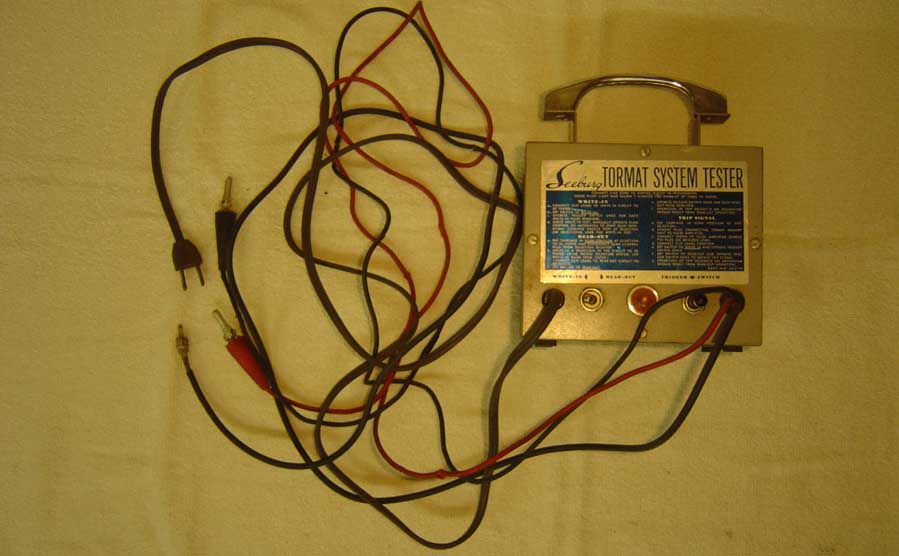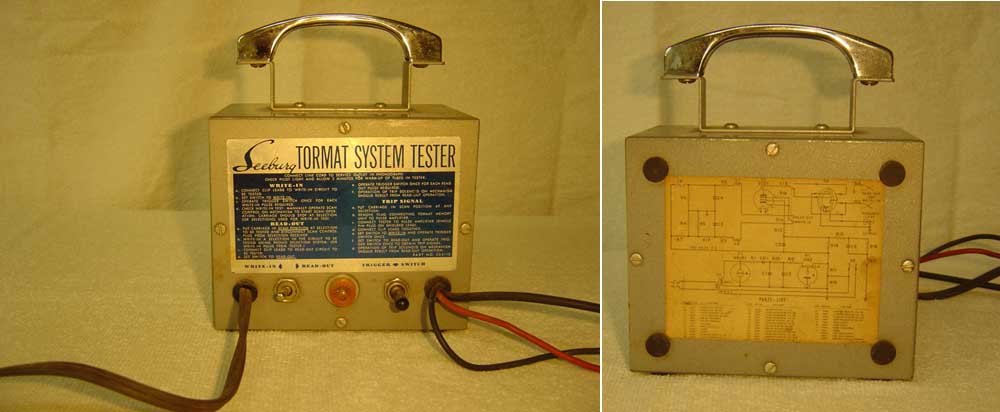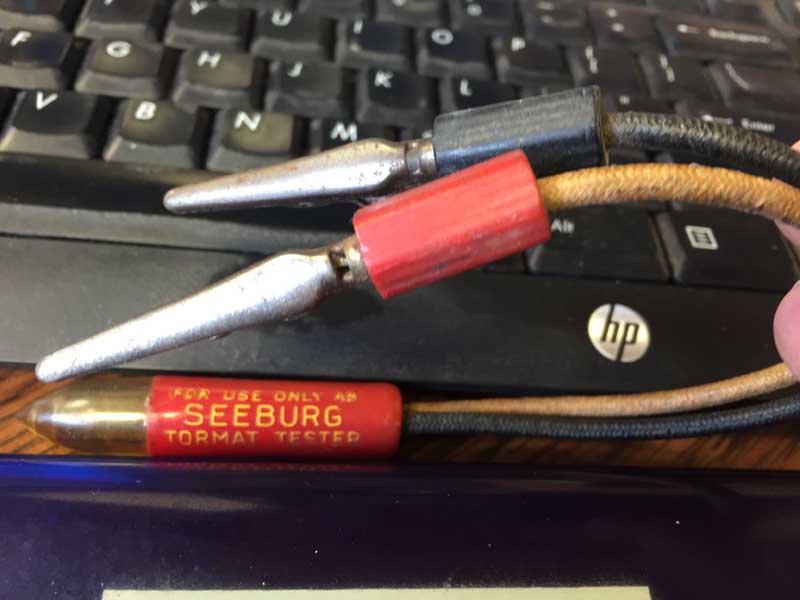|
Was ist ein Tormat? |
|
What is the Tormat? |
|
Der Tormat wurde mit der
V200 eingeführt. Das Wort stammt von Toroiden Matrix und
wurde von Carl McKelvey im August 1955 (Marketing) geprägt.
Bei dem Tormat wurde die bisherige Anordnung aus einem Elektromagneten
und einem mechanischen Schalter für jede Plattenseite (Pin-Bank) durch
einen magnetischen Ringkernspeicher, dem Toroiden, pro Plattenseite
ersetzt.
Der Tormat speichert die Plattenauswahlen durch Polarisierung der
Ferritkerne solange, bis sie durch Umpolen wieder gelöscht werden.
Ferrit hat magnetische Eigenschaften und eignet sich daher besonders
gut. Verwendet wurde der Tormat von der V200 (1955) bis zur STD4/100-78D
(1977/1978).
Ab der SMC1 (1978) wurde
das Microcomputer Control System (MCU) verwendet.
|
|
The Tormat was introduced with
the V200. The word comes from Toroidal Matrix and was
coined by Carl McKelvey in August 1955 (marketing).
With the Tormat, the previous arrangement of an electromagnet and a
mechanical switch for each record side (pin bank) was replaced by a
magnetic toroidal core memory, the toroid, for each record side.
The toroid stores the record selections by polarizing the ferrite cores
until they are deleted by reversing the polarity. Ferrite has magnetic
properties and is therefore particularly suitable. The Tormat was used
from the V200 (1955) to models STD4/100-78D (1977/1978).
Starting with SMC1 (1978), the
Microcomputer Control System (MCU) was used. |
|
|
|
Einstellung Tormat |
|
Adjustment Tormat |
|
Die Einstellung des Tormaten ist im
jeweiligen Service Manual detailliert beschrieben. Sie ist nicht allzu
schwierig.
Am besten stellt man das Laufwerk händisch so, dass entweder die erste
oder die letzte Platte in der Zugriffsposition ist. Dann hebt man den
Release Lever an und startet den Motor mir dem MECH START - Schalter,
damit die Platte in Spielposition gehoben wird. Dabei wird das Laufwerk
verriegelt und vor dem Plattenfach zentriert.
Zur Kontrolle: der Detent Switch (der Kontakt hinter dem Motor) müsste
geschlossen sein. Nun kann man den Tormat so verschieben, dss der
Schleifkontakt genau auf der ersten Kontaktniete steht. Abschließend
sollte die Einstellung nochmals kontrolliert werden, indem einige
Platten am anderen Ende und in der Mitte des Magazins abgespielt werden.
Dabei kontrolliert man, ob der Schleifkontakt immer genau mittig auf der
Kontaktniete steht. Manchmal ist noch eine kleine Korrektur um einige
Zehntel Millimeter nötig.
|
|
The setting of the Tormat is
described in detail in the equivalent service manual. It is not too
difficult.
It is best to set the carriage manually so that either the first or the
last record is in the access position. Then lift the release lever and
start the motor with the MECH START switch so that the record is pickd
up into the playing position. In doing so the carriage is locked and
centered in front of the record compartment.
To check: The detent switch (the contact behind the motor) should be
closed. Now you can move the Tormat so that the sliding contact is
exactly on the first contact rivet. Finally, the setting should be
checked again by playing a few records at the other end and in the
middle of the magazine. At this point, check that the sliding contact is
always exactly centered on the contact rivet. Sometimes a small
correction of a few tenths of a millimeter is necessary.
|
|
|
|
Seeburg Tormat System Tester |
| Passend für all Modelle mit
Tormat: V200 (1955) – STD4 / 100-78D (1978) |
Suitable for all models with tormat: V200 (1955) – STD4 /
100-78D (1978) |
Pictures
courtesy
Benjamin
Thoburn


 |
|
|
|
Löschen aller
gespeicherten Wahlen im Tormat
Modelle mit SCC und DCC |
|
Deleting all selections stored in the tormat
Models with SCC and DCC |
|
Es werden nach dem Einschalten alle Singles der Reihe
nach abgespielt. Anscheinend sind alle Wahlen aktiviert (z.B. durch den
sog. Batterietest).
Wie können die Wahlen gelöscht werden?
Antwort: Eine Möglichkeit ist, den Batterietest
mit umgekehrter Polarität anzuwenden. Im Falle der DCC und SCC (Halbleiter-bestücktes
Control Center) kommt der Minus-Pol der Batterie an Masse, der Pluspol
an den Mittelstift des Steckers.
Einfacher jedoch ist es, das Cinchkabel am
Control Center (SCC oder DCC) abzuziehen und einen Suchlauf zu starten - durch
Betätigen des Schalters "Mech. Start". Wenn das Kabel abgezogen ist,
sollte das Laufwerk nur mehr hin- und herfahren, aber keine Platte
abspielen. Danach sollten alle Wahlen gelöscht sein. Wenn dann das
Kabel wieder angesteckt und erneut ein Suchlauf gestartet wird, sollte
das Laufwerk nur zweimal hin und herlaufen, ohne eine Platte zu spielen.
Danach sollte es möglich sein, eine Wahl zu tätigen.
Voraussetzung hierfür ist, daß der Read Out-Kreis ordnungsgemäß und
fehlerfrei funktioniert. Wenn nicht, kann eine Anzahl von Wahlen
weiterhin gespeichert sein und bei einem der folgenden Suchläufe
gefunden werden. Daher ist diese Methode gleichzeitig ein Test für die
einwandfreie Funktion des Read Out-Kreises. |
|
After switching on, all records
are played in sequence. Apparently all selections are activated (e.g. by
the so-called
battery test).
How can the selections be deleted?
Answer: One possibility
is to use the
battery test
with reversed polarity. In the case of the DCC and
SCC (semiconductor-equipped control center), the negative pole of the
battery is connected to ground and the positive pole to the center pin
of the connector.
However, it is easier to disconnect the cinch cable from the control
center (SCC or DCC) and start a search run - by pressing the "Mech.
Start" switch. When the cable is disconnected, the carriage should only
move back and forth, but not play a record. All selections should then
be deleted. If the cable is then reconnected and a search run is started
again, the carraige should only run back and forth twice without playing
a record. It should then be possible to make a selection.
For this it is required that the read-out circuit is working properly
and without errors. If not, a number of selections may still be stored
and can be found during one of the subsequent searches. This method is
therefore also a test for the proper functioning of the read-out circuit.
|
|
|
|
Funktionstest
Read-Out / Auslesen der Wahlen - Modelle mit Tormat |
|
Test of function read-out of selections -
models with tormat |
|
Sog.
Batterietest zum Testen des Read-Out-Vorgangs
für Geräte mit Röhren: den Cinchstecker vom Impulsverstärker abziehen und
kurzzeitig den Minuspol einer 1,5 V-Batterie mit Masse und den
Pluspol mit dem Mittelstift des Steckers verbinden. Dadurch werden alle Musikstücke
gewählt. Danach die Leitung wieder anstecken und eine Platte wählen (um
den Scanvorgang zu starten). Der Serviceschalter muss in PLAY-Position
sein. Jetzt müssten der Reihe nach alle Musikstücke gespielt werden. Wenn
das der Fall ist, ist der Read Out - Vorgang (einschließlich
Impulsverstärker) in Ordnung und der Fehler liegt am Write In.
Sog. Batterietest zum Testen des
Read-Out-Vorgangs für Geräte mit Halbleiterbestückung: den
Cinchstecker vom Impulsverstärker abziehen und kurzzeitig den
Minus-Pol einer 1,5V-Batterie mit mit dem Mittelstift des Stecker und
den Pluspol mit Masse verbinden. Dadurch
werden alle Musikstücke gewählt. Danach die Leitung wieder anstecken und
eine Platte wählen (um den Scanvorgang zu starten). Der Serviceschalter
muss in PLAY-Position sein. Jetzt müssten der Reihe nach alle Musikstücke
gespielt werden. Wenn das der Fall ist, ist der Read Out - Vorgang
(einschließlich Impulsverstärker) in Ordnung und der Fehler liegt am
Write-In.
Ohne Batterietest: Man zieht das Cinchkabel am
Control Center (SCC oder DCC) ab und startet einen Suchlauf durch
Betätigen des Schalters "Mech. Start". Wenn das Kabel abgezogen ist,
sollte das Laufwerk nur mehr hin- und herfahren, aber keine Platte
abspielen. Danach sollten noch mögliche Wahlen gelöscht sein. Wenn dann das
Kabel wieder angesteckt und erneut ein Suchlauf gestartet wird, sollte
das Laufwerk nur zweimal hin und herlaufen, ohne eine Platte zu spielen.
Danach sollte es möglich sein, eine Wahl zu tätigen.
Wenn es so funktioniert, ist der Read-Out-Kreis in Ordnung. |
|
So called battery test to
test the read-out process for
jukeboxes with valves:
Disconnect the RCA plug from the pulse amplifier and briefly connect the
negative terminal of a 1.5 V battery to earth and the positive terminal
to the center pin of the plug. This will select all music titles. Then
reconnect the cable and select a record (to start the scanning process).
The service switch must be in the PLAY position. All music ttitles
should now be played in sequence. If this is the case, the
read-out-circuit (including the pulse amplifier) is OK and the fault
lies with the write-in circuit.
So called battery test to
test the read-out process for
jukeboxes with semi conductors:
Disconnect the RCA plug from the pulse amplifier and briefly connect the
negative terminal of a 1.5 V battery with the center pin of the plug and
the positive terminal to to earth. This will select all music titles.
Then reconnect the cable and select a record (to start the scanning
process). The service switch must be in the PLAY position. All music
ttitles should now be played in sequence. If this is the case, the
read-out-circuit (including the pulse amplifier) is OK and the fault
lies with the write-in circuit.
Without battery test:
Disconnect the cinch cable from the Control Center (SCC or DCC) and
start a search run by pressing the "Mech. Start" switch. When the cable
is disconnected, the carriage should only move back and forth, but not
play a record. Possible selections should then be deleted. If the cable
is then reconnected and a search run is started again, the carriage
should only run back and forth twice without playing a record. It should
then be possible to make a selection.
If it works like this, the read-out circuit is OK.
|
|
|
|
Bei den
B-Seiten wird generell eine Single nach der eigentlichen Wahl
abgespielt, z.B. K6 statt K8 - Modelle mit Tormat. |
|
With B-sides
always one record after of the selected one gets picked up e.g. K6
instead of K8 - models with tormat. |
|
Der Tormat ist gereinigt
und justiert und die A Seiten werden zu 100 % korrekt abgespielt. Das
Problem sind die B Seiten. Statt A2 wird A4 gespielt, statt K6
wird K8 gespielt, also generell eine Single später im Register und das
durch alle Buchstaben. Was kann der Fehler sein?
Antwort:
Das liegt vermutlich an einer Fehljustierung des Tormats.
Der Schlitten erkennt nach getätigter Wahl die Position zum Stoppen,
wenn ein Kontakt auf dem Kontaktblock, der sich mit dem Schlitten
bewegt, auf die entsprechende Kontaktniete an der Tormat-Einheit trifft.
Wenn das passiert, wird die "Bremse" des Schlittens aktiviert. Diese
Bremse kann den Schlitten allerdings nicht an jeder Stelle zum stehen
bringen, sondern zentriert ihn so, dass er genau ein Platte greifen
kann. Wenn die Bremse also etwas zu spät aktiviert wird, dann wird nicht
die gewählte, sondern die nächste Platte abgespielt.
Wenn der Tormat zu weit rechts steht, wäre im Extremfall zu erwarten,
dass bei A-Seiten immer die nächste, und bei B-Seiten immer die
vorherige Platte abgespielt wird.
Wenn die Fehljustierung nicht ganz so extrem ist, und man davon ausgeht,
dass es gewisse Verzögerungen (z.B. durch die Massenträgheit) gibt, kann
es zum o.g. Problem kommen.
|
|
The Tormat got cleaned and
adjusted and the A sides get played 100% correctly. The problem are the
B sides. Instead of A2 title A4 is played, instead of K6 it is K8, i.e.
generally one record located later in the magazin and this with all
letters. What could be the error?
Answer: This is probably
due to a misalignment of the Tormat.
After the selection has been made, the carriage recognizes the position
for stopping when a contact on the contact block, which moves with the
carriage, hits the corresponding contact rivet on the Tormat unit.
When this happens, the "brake" of the carriage is activated. However,
this brake cannot bring the carriage to a standstill at any point, but
centers it so that it can pick up exactly one record. If the brake is
activated a little too late, the next record will be played instead of
the one selected.
If the Tormat is too far to the right, in extreme cases it would be
expected that the next record would always be played for A-sides, and
the previous record for B-sides.
If the misalignment is not quite so extreme and it is assumed that there
are certain delays (e.g. due to inertia), the above-mentioned problem
may occur.
|
|
|
Die erste Single aus dem Magazin wird nicht genommen
Modell SE100 und vergleichbare |
|
The first record in the magazin does not get
picked up
Model SE100 and similar |
|
Eine Golden Jet nimmt die Single aus dem ersten Fach nicht mehr auf (A1
und A2). Ab A3 funktioniert alles problemlos.
Antwort: Vermutlich wird die Laufrichtung zu früh umgeschaltet -
bevor A1 erreicht wird. Für die Umschaltung ist der Reversing Switch
zuständig, das ist der Kontaktsatz mit dem langen Hebel ganz vorne unten
auf dem Laufwerk. Wenn der Hebel auf das Anschlagstück links oder rechts
aufläuft, wird der Kontaktsatz (und damit die Laufrichtung)
umgeschaltet. Die Anschlagstücke sind durch Lockern der
Befestigungsschrauben verschiebbar. Wahrscheinlich genügt es das linke
Anschlagstück um 2-3mm nach links zu verschieben.
|
|
A Golden Jet no longer picks up
the record from the first compartment (A1 and A2). From A3 onwards,
everything works without any problems.
Answer: The scanning
direction is probably switched too early - before A1 is reached. The
reversing switch is responsible for the changeover; this is the contact
set with the long lever at the very front bottom of the carriage. When
the lever hits the end stop on the left or right, the contact set (and
thus the running direction) is switched over. The end stop can be moved
by loosening the fastening screws. It is probably sufficient to move the
left-hand end stop 2-3 mm to the left.
|
|
Die Angaben haben keinen
Anspruch auf Vollständigkeit oder Richtigkeit.
Bei den (importierten) Boxen können im Laufe der Jahre durchaus
Veränderungen vorgenommen worden sein. Copyright.
<<< zurück
zur Archiv-Übersicht
|
|
Ein Service von

Copyright by Stamann
Musikboxen |



